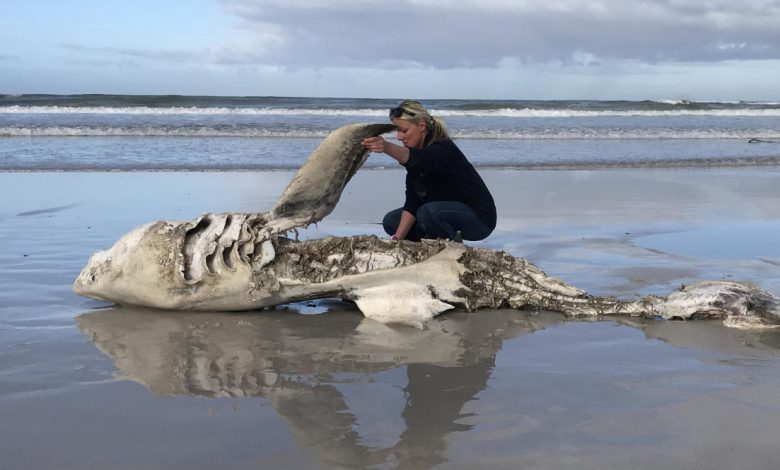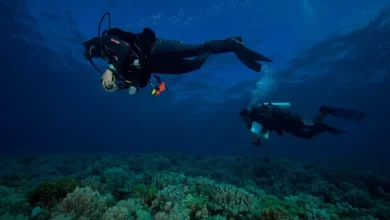
Lead Image: Lead author Alison Towner with the carcass of a Great White Shark washed up on shore following an Orca attack. Credit: Marine Dynamics/ Dyer Island Conservation Trust. Image by Hennie Otto
The new research adds to our knowledge of how Great Whites employ their “flight” instincts to evade predators over long periods of time and in groups.
Large numbers of Great White Sharks have been driven away from their normal gathering place by a pair of Orca (Killer Whales) who have been terrorizing and slaughtering the sharks off the coast of South Africa since 2017.
New research published in the peer-reviewed African Journal of Marine Science utilizes long-term sightings and tagging data to reveal that Great Whites have been avoiding particular sections of the Gansbaai coast – territory that they have controlled for many years – out of fear of being hunted by Orcas.
Eight Great White Sharks have washed up on the beach since 2017 as a result of an Orca attack. Seven of them had their livers removed, and some were also missing their hearts. The same pair of orcas, who are likely to have killed more (which haven’t washed ashore), left behind characteristic marks on their bodies. Other Orcas are known to be able to carry out similar assaults.
The findings support the theory that sharks employ their fear-induced “flight” response to initiate large mass emigration when a marine predator is close.
In this most recent study, which took place over 5.5 years, 14 sharks have been detected leaving the locations where the orcas are present, and visual sightings have sharply decreased in the Western Cape Bays. With people from all over the world coming and participating in cage diving, Gansbaai, which is about 100 km east of Cape Town, was a well-known location for witnessing this famous shark.
Reporting on the findings, lead author Alison Towner, a Senior White Shark Biologist, at the Dyer Island Conservation Trust, says: “Initially, following an Orca attack in Gansbaai, individual Great White Sharks did not appear for weeks or months. What we seem to be witnessing though is a large-scale avoidance (rather than a fine-scale) strategy, mirroring what we see used by wild dogs in the Serengeti in Tanzania, in response to increased lion presence. The more the Orcas frequent these sites, the longer the Great White Sharks stay away.
“The research is particularly important, as by determining how large marine predators respond to risk, we can understand the dynamics of coexistence with other predator communities; and these dynamics may also dictate the interactions between competitors or intra-guild predator/prey relationship.”
Alison, from Lancashire in the UK, is a Ph.D. candidate at Rhodes University in Makhanda, Eastern Cape. She lives in Gansbaai and has studied Great White Sharks for the last 15 years, learning about their movement patterns through tagging data. Regularly found on a boat and having witnessed many huge Great White Sharks, she has previously described the area as “simply special, in terms of marine life – few places compare to this truly diverse and beautiful area”.
Prior to these predations on the Great White Sharks, there were only two instances since data collection began in Gansbaai where they were absent for a week or more: one week in 2007 and 3 weeks in 2016.
So, what Alison, and other colleagues at institutions she represents such as Marine Dynamics Academy, have recently witnessed first-hand (by physically retrieving the carcasses of attacked sharks – as pictured) is this new absence is unprecedented for the area.
And, she explains, it is changing the sea’s very ecosystem: “It has triggered the emergence of a new mesopredator to the area, the Bronze Whaler Shark – which is known to be eaten by the Great White Shark – and these Bronze Whalers are also being attacked by the Orcas too, who are indicating a level of experience and skill in hunting large sharks.
“However, balance is crucial in marine ecosystems, for example, with no Great White Sharks restricting Cape Fur seal behavior, the seals can predate on critically endangered African Penguins, or compete for the small pelagic fish they eat. That’s a top-down impact, we also have ‘bottom up’ trophic pressures from extensive removal of Abalone, which graze the kelp forests these species are all connected through.
“To put it simply, although this is a hypothesis for now, there is only so much pressure an ecosystem can take, and the impacts of Orcas removing sharks, are likely far wider-reaching.”
But, what drew the pair of Orcas, easily recognizable by their distinctive collapsed dorsal fins, to this new territory?
Other, yet-to-be-published data, suggests the Orcas’ presence is increasing in coastal regions of South Africa and this pair might be members of a rare shark-eating morphotype, known to hunt at least three shark species as a prime source of nutrition in South Africa.
“This change in both top predators’ behavior could,” Alison says, “be related to a decline in prey populations, including fishes and sharks, causing changes in their distribution pattern.
“We know that Great White Sharks face their highest targeted mortality in the anti-shark bather protection nets in KwaZulu Natal, they simply cannot afford additional pressure now from Orca, killer whale predation.”
What it means for populations of the Great White could be more pronounced and it is “unclear” what the pressure may do, Alison states.
“The Orcas are targeting subadult Great White Sharks, which can further impact an already vulnerable shark population owing to their slow growth and late-maturing life-history strategy. Increased vigilance using citizen science (e.g. fishers’ reports, tourism vessels), as well as continued tracking studies, will aid in collecting more information on how these predations may impact the long-term ecological balance in these complex coastal seascapes.”
As with all studies, alternative explanations for the findings should be considered. The authors suggest that sea surface temperature can have an impact on the Great White’s recent absence, “however, the immediate and abrupt decline in sightings at the beginning of 2017 and the extended and increasing periods of absence cannot be explained” by this.
“Other potential explanations for a decline at Gansbaai,” they say, “could be direct fishing of Great White Sharks or the indirect effect of fishery-induced declines in potential prey”. However, they state that while this could “potentially contribute to an overall decline in numbers of Great Whites in South Africa, they are unlikely to explain the sudden localized decline”.
Reference: “Fear at the top: killer whale predation drives white shark absence at South Africa’s largest aggregation site” by AV Towner, RGA Watson, AA Kock, Y Papastamatiou, M Sturup, E Gennari, K Baker, T Booth, M Dicken, W Chivell, S Elwen, T Kaschke, D Edwards and MJ Smale, 29 June 2022, African Journal of Marine Science.
DOI: 10.2989/1814232X.2022.2066723


